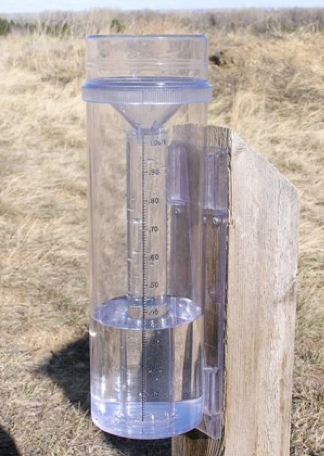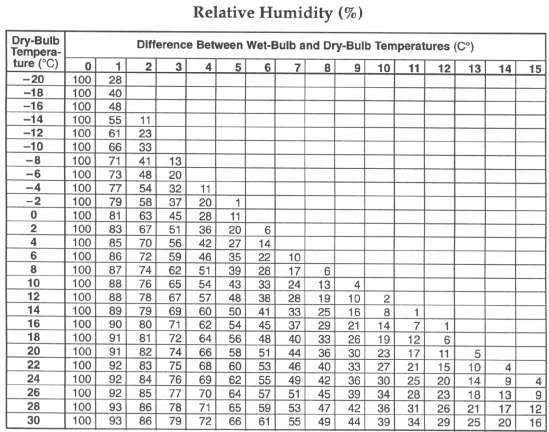How do we measure the weather and climate?
Weather instruments are used to take measurements of temperature, wind, precipitation, and other atmospheric factors that describe the local weather and climate. Different types of instruments are used to measure these parameters and there are many types to choose from. Our ECONet weather towers measure a variety of these parameters, such as temperature, wind speed, wind direction, humidity, precipitation, atmospheric pressure, solar radiation, and even soil temperature and moisture!
You’re probably familiar with thermometers as they’re very common in our daily lives (indoor & outdoor temperature, body temperature, oven temperature, etc.). Think about what a thermometer looks like. Chances are you probably thought of the classic glass tube filled with red-dyed alcohol – replacing toxic mercury-filled instruments (Figure A). As the temperature of the instrument changes, so too does the volume of the liquid inside of the thermometer – the red liquid rises as the temperature rises due to the liquid expanding up the tube, and falls with the temperature due to the liquid contracting back into the bulb at the bottom. At modern weather stations, like our ECONet towers, an electronic temperature sensor is used to measure the outside air temperature (Figure B). The temperature sensor on this device is contained within a vented unit which allows air to flow freely across the sensor and measure the temperature while keeping the thermometer shaded from the direct heating of the sun.
An anemometer is an instrument that measures wind speed and they’re very common at weather stations. There are a few different types of anemometers, one of the most common being a cup anemometer (Figure C – right side). As the wind blows, it pushes the cups and causes the arms to rotate at a rate proportional to the wind speed. This is great for measuring wind speed, but doesn’t help us measure the wind direction. A wind vane can help us to measure which direction the wind is coming from (Figure C – left side). As the wind blows past the instrument, the wind vane will point in the direction that the wind is coming from. It is important to note that wind direction is always given by where the wind is coming from, so a west (or westerly) wind is blowing from west to east. Many weather stations, including our ECONet towers, use a tool that combines these two instruments into one called a propeller anemometer (Figure D). Because propeller anemometers measure both speed and direction simultaneously, they are considered to be more accurate than the two separate instruments.


A rain gauge is an instrument used to measure the amount of precipitation over a certain amount of time. In its most basic form, a rain gauge can be a bucket that collects rain water to be measured by a ruler (Figure E). For our ECONet towers and other officially recognized weather stations, the instruments are more precise than the bucket & ruler method. Specifically, our ECONet rain gauges are known as tipping bucket gauges (Figure F) – when the gauge fills to a certain level (0.01″), the gauge tips and empties so as to avoid overflowing or clogging. The number of bucket-tips are counted and the precipitation is calculated. For example, if the bucket tips 25 times over the course of the day, we can calculate that it rained 0.25″ that day.
In order for rain gauges to be as precise as possible, they need to be placed in open areas with no obstructions like trees or buildings. The goal in measuring weather is always accuracy, but sometimes real-world weather conditions impede our measurements. During hurricanes or strong thunderstorms high winds can prevent the rain from falling into the gauge or even blow debris into the instrument, blocking the gauge’s opening.
If you’re interested in contributing precipitation data from your own backyard, consider joining CoCoRaHS (Community Collaborative Rain, Hail & Snow Network). It’s a nationwide volunteer network of backyard weather observers of all ages and backgrounds working together to measure and map precipitation (rain, hail and snow) in their local communities. You can take a look at a live map of today’s measurements here!


Atmospheric pressure, or air pressure, can be measured using a barometer. An aneroid barometer (Figure G), one of the most common types, uses a sealed container of air to detect changes in the atmospheric pressure outside of the container. As the atmospheric pressure increases, it pushes down on the container and it is slightly reduced in volume, moving an indicator needle towards higher pressure. If the atmospheric pressure decreases, the container expands slightly and the needle indicates lower pressure. Most weather stations, including our ECONet towers, now use digital barometers as they’re much easier to maintain and collect data.
Why is it important to measure atmospheric pressure?
Measuring pressure is important because it is related to volume, density, and temperature. In the atmosphere, warm surfaces can heat the air above them causing the air to become less dense and to rise. This leads to low pressure and can eventually result in clouds and precipitation in the areas of rising motion. On a large scale, these low pressure systems can become large storm systems, such as hurricanes. On the other hand, high pressure in the atmosphere causes the cold air to compress and sink, leading to clear skies and calm conditions. Notice the associated weather on the barometer in Figure H.


What is humidity?
Humidity is defined as the measure of moisture in the air. While humidity can be measured in grams of water per kilogram of air (absolute humidity), it’s more practical to work with relative humidity as it can give us a better sense of how the weather might be affected by the water in the air. If the relative humidity is measured to be 100%, the air is saturated. If the relative humidity is 50%, the air contains half of the water vapor required to be saturated. It is important to keep in mind that relative humidity is also dependent on air temperature. For example, if the water vapor content stays the same and the temperature drops, the relative humidity increases. If the water vapor content stays the same and the temperature rises, the relative humidity decreases. This is because colder air doesn’t require as much moisture to become saturated as warmer air.
How is relative humidity measured?
Relative humidity can be measured using a hygrometer. There are many different types of hygrometers, but they’re all similar in that they measure the temperature in two different ways – using a dry-bulb thermometer and a wet-bulb thermometer. The dry-bulb thermometer will simply measure the air temperature while the wet-bulb measures evaporative cooling. Evaporative cooling is the reason you feel cold after getting out of a swimming pool or the shower. The water uses heat energy from your body and your skin cools to the wet-bulb temperature (which is why you feel a chill until the water evaporates).
A sling psychrometer (Figure I) is a common type of hygrometer used to determine relative humidity. Sling psychrometers use two thermometers (one dry-bulb, one wet-bulb) to measure and compare the air temperature versus the evaporative cooling. These measurements are then compared to a relative humidity chart (Figure J) to calculate relative humidity.



